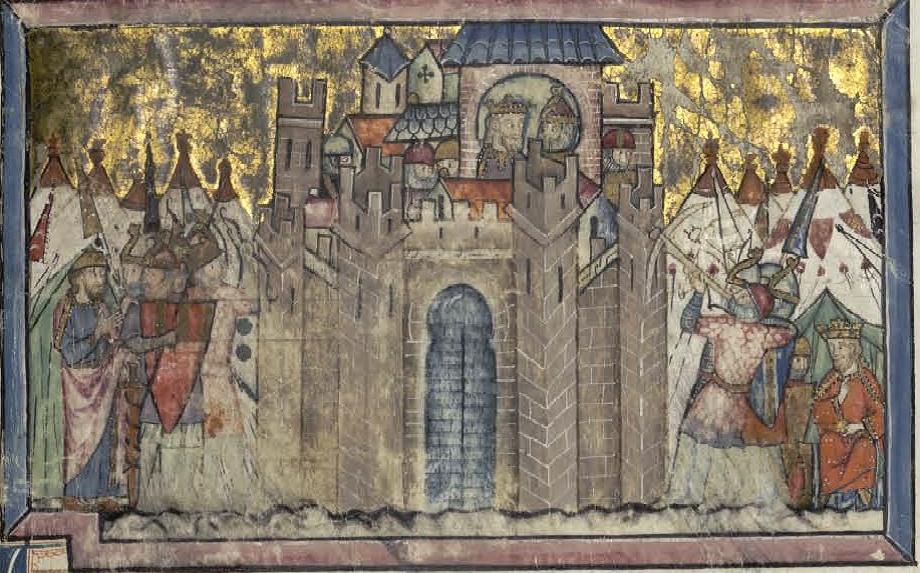
Create an Amazon Business Account
Gran Conquista de Ultramar, Spain, 1295

Source: Manuscript Miniatures


BNE MSS 1187 Gran Conquista de Ultramar, Biblioteca Nacional de España
Spain, 1291-1295.
La Gran conquista de Ultramar es un relato medieval castellano que contiene una crónica muy novelesca de la conquista de Jerusalén durante la Primera Cruzada y que data de entre 1291 y 1295 en su primera redacción. En el texto se incluyen narraciones independientes de gran interés procedentes de la épica francesa, como la historia de El Caballero del Cisne, Berta la de los grandes pies o el Mainete. El manuscrito más antiguo y también más extenso en el que se nos ha transmitido (360 folios) se conserva en la Biblioteca Nacional de Madrid y fue compuesto en 1295.
La Gran conquista de Ultramar (The Great Conquest of Outremer) is a medieval Castilian account containing a very novelistic chronicle of the conquest of Jerusalem during the First Crusade, dating from between 1291 and 1295 in its first draft. The text includes independent narratives of great interest from the French epic, like the story of the Knight of the Swan, Berta of the big feet or Mainete. The oldest manuscript and also the largest which has been transmitted to us (360 pages) is preserved in the National Library of Madrid and was composed in 1295.
Gran conquista de Ultramar
[Great conquest of Outremer]
ca 1289-95. Castile (Iberia). Castilian crusade chronicle compiled of translations of several French and Provençal works. It covers events in the Holy Land from 1095 to 1271/75 with a preamble devoted to the Byzantine emperor Heraclius I as proto-crusader. Although the title Gran conquista de Ultramar is well-known, other titles found in the manuscripts themselves-Grant estoria de Ultramar or Estoria mayor de Vltramar (Great history of Outremer)-better suit the chronicle's strategy and difference from other more restricted histories, such as the Estoria de Gerusalem abreviada (Abridged history of Jerusalem). In fact, the main aim of the Gran Conquista is to give a complete account of all facts about Outremer.
With this motivation, several works were translated from French or Provençal and combined in one single narrative. The Estoire de Eracles empereur et la conqueste de la terre d'Outremer (History of the emperor Heraclius and the conquest of Outremer), a translation of William of Tyre's Historia rerum in partibus transmarinis gestarum, provided the compilers with a coherent framework to include prosifications of the first French crusade cycle (Naissance du Chevalier au Cygne, Chevalier au Cygne, Enfances Godefroi, Chanson d'Antioche, Chétifs, Chanson de Jérusalem), the Provençal Canso d'Antioca and other sources not yet known.
Although the Gran Conquista is traditionally attributed to Alfonso X, contemporary research has shown that his successor Sancho IV (1284-95) was responsible for the gathering of materials, control of translation, and assessment of the compilatory process. The colophon of the oldest surviving manuscript (Madrid, BNE, ms. 1187) attributes authorship to this king. In fact, this manuscript is the third and last volume of the royal codex, with only two miniatures, probably due to Sancho IV's death in April 25, 1295. The Gran Conquista recounts the deeds of a heroic lineage, from the Knight of the Swan and the conquest of the Holy Land by his grandson Godfrey of Boulogne to the final territorial and moral defeat. The chronicle was thus an instrument to explore the limits of legitimate authority, a most important issue in Sancho IV's court.
Three other manuscripts (Madrid, BNE, ms. 1920, BNE, ms. 2454 and Salamanca, BU, ms. 1698) contain fragmentary versions of the Gran Conquista. The editio princeps was by Hans Giesser (Salamanca, 1503). This edition, with formal features of the so-called chivalry genre, has been most influential on literary historians' interpretations of the work. The mixture of historical writing (William of Tyre) and fiction (epic cycle) has generally been misunderstood in favour of the latter.
Bibliography
Text:
L. Cooper, La Gran Conquista de Ultramar, 1979.
L. Cooper & F.M. Walkman, La Gran Conquista de Ultramar: Biblioteca Nacional MS 1187, 1989.
M.T. Echenique, La leyenda del Caballero del Cisne, 1989.
P. de Gayangos, La Gran Conquista de Ultramar, 1858, reprint 1950.
R. Harris-Northall, Text and Concordances of the "Gran Conquista de Ultramar" (BNM R-518, R-519), 1994.
Literature:
C. Domínguez, "El maestre Hans Giesser y el trabajo editorial: de la Grant estoria de Ultramar a la Gran conquista de Ultramar", in A. Deyermond, Proceedings of the Tenth Colloquium, 2000, 115-130.
C. Domínguez, "La Grant estoria de Ultramar (conocida como Gran conquista de Ultramar) de Sancho IV y la Estoire de Eracles empereur et la conqueste de la terre d'Outremer", Incipit, 25-6 (2005-6), 189-212.
C. González, La tercera crónica de Alfonso X: "La Gran Conquista de Ultramar", 1992.
G. Paris, "La Chanson d'Antioche provençale et La Gran Conquista de Ultramar", Romania, 17 (1888), 513-41; 19 (1890), 562-91; 22 (1893), 345-63.
G.T. Northup, "La Gran Conquista de Ultramar and Its Problems", Hispanic Review, 2 (1934), 287-302. RepFont 3, 607.
CESAR DOMÍNGUEZ PRIETO